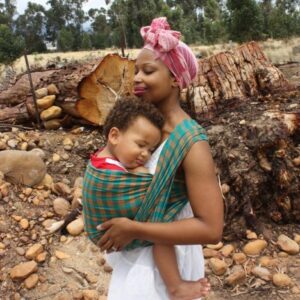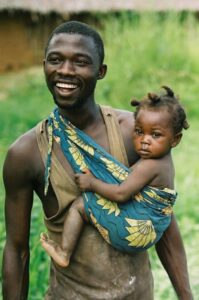Celebrate babywearing and its African origins
 As Black women, we have been wearing our babies for centuries. In fact, the first American version of a babywearing device was invented by a woman who had just returned from a trip to West Africa. She was traveling with the Peace Corps and had observed women in Togo carrying their babies on their bodies. She invented the “Snugli” when she got back to the United States and decades later, babywearing has boomed into an entire industry. There are so many reasons why this tradition has become a mainstream practice and we even have a week to celebrate its benefits; International Babywearing week is in the month of October.Necessity and convenience are likely what led to this creative innovation. Wearing their babies allowed them to care for their children while working and multitasking. Keeping their babies on their bodies allowed them to continue to bond with their little one, making the 4th-trimester transition easier for both mother and child, while simultaneously protecting their babies from danger. The physical bond provided by wearing babies not only enhances our connection with our children but also positively impacts postpartum blues for those who suffer. Additionally, if a child is being breastfed, mothers are able to discreetly and conveniently nurse in some carriers. Worn babies tend to cry less and quite simply, mothers are just able to accomplish more while still tending to their children when they’re able to comfortably wear them.
As Black women, we have been wearing our babies for centuries. In fact, the first American version of a babywearing device was invented by a woman who had just returned from a trip to West Africa. She was traveling with the Peace Corps and had observed women in Togo carrying their babies on their bodies. She invented the “Snugli” when she got back to the United States and decades later, babywearing has boomed into an entire industry. There are so many reasons why this tradition has become a mainstream practice and we even have a week to celebrate its benefits; International Babywearing week is in the month of October.Necessity and convenience are likely what led to this creative innovation. Wearing their babies allowed them to care for their children while working and multitasking. Keeping their babies on their bodies allowed them to continue to bond with their little one, making the 4th-trimester transition easier for both mother and child, while simultaneously protecting their babies from danger. The physical bond provided by wearing babies not only enhances our connection with our children but also positively impacts postpartum blues for those who suffer. Additionally, if a child is being breastfed, mothers are able to discreetly and conveniently nurse in some carriers. Worn babies tend to cry less and quite simply, mothers are just able to accomplish more while still tending to their children when they’re able to comfortably wear them.• • •
Ann Moore (Togo) — The Volunteer Who Invented the Snugli
After graduating from the University of Cincinnati, Ann Moore taught pediatric nursing at Babies Hospital, Colombia University, in New York.
In 1962, the Chief Resident of Pediatrics at Babies Hospital was asked to organized the first Peace Corps medical team to go to Togo, and Ann was recruited along with 30 other medical and health specialists — doctors, nurses, lab techs, a pharmacist, and a sanitation engineer. Their mission was to teach preventive care.
For the entire first year in Togo they worked in an abandoned hospital where they treated —and nurtured patients back to health. In the second year, they were able to teach various good health promoting behaviors — like nutrition, latrine building, hand washing, etc. The volunteers all noted and remarked about the outstanding emotional well-being of African infants, either sick or healthy. All of the babies and toddlers were carried on their mothers’ back, and they were all breastfed. When the babies were not asleep on their mothers’ back, they were alert, curious, looking around and appearing to be very content.
While working as a volunteer nurse in Togo, Ann had seen something interesting being done by African mothers — they carried their little ones in fabric slings that were securely tied to their backs. She liked how close the mothers and their babies were this way, and noticed how the babies looked calm because they felt secure due to their closeness to their mothers. In the market place, there was very little crying. At the hospital, the mothers brought their baby’s other siblings along and they all camped out on floor mats. This “backward” nation was doing “rooming in” long before hospitals in the U. S. started this practice.
Inventing the first commercial child carrier during the 1960s.
When Ann returned home she had a child of her own, Mande, and she wanted to carry her little one in the same way the Togolese mothers did. Starting with a simple backpack, then relining it to suit her needs, she, together with her mother, developed a carrier that resembled those used by mothers in Togo. They created the “Snugli,” the original soft baby carrier.
In the early 1960s, no one in the U. S. carried their babies in this manner; they carried them in plastic infant seats that didn’t permit a warm body connection between baby and mother. The LaLeche League and natural child-birth were just becoming popular with mothers, and when they saw Ann wearing Mande on her back, they asked: where they could purchase this type of carrier? Ann called her mother who went to a fabric store and purchased 2 yards of corduroy to sew another carrier.
Demand for this type of carrier took off from this point, and Ann’s mother turned to friends for help. Subsequently, at one time, they had 150 women in the Dayton, Ohio area making Ann’s baby carriers — a wonderful cottage industry. As demand continued, they created a focus group that went on to call the baby carrier the “Snugli.” They applied for a patent and it was granted in 1969. Initial sales were mostly mail order in the first few years and then later retail outlets became interested. They even created a “Snugli” for premature infants and twins!
Ann introduced “Snugli” to the European market in 1976 and to Japan in 1979. By the time Ann sold the company in 1985, over 1.5 million babies had been carried in “Snuglis.”
Then, in 1986, Ann started another company called “Air Lift Unlimited.” She designed a way for people who are oxygen dependent to carry their tanks. She created and patented a backpack for portable oxygen — and this took her company into home health care. She then sold that company in 2013.
Ann’s “Snugli” company was given an award for realizing the 3rd Goal of Peace Corps which is to bring home something we learned in our 2-year experience overseas, and introduce that into our own culture. There are now many types of baby carriers, a fact which gives Ann great joy for all of that ‘bonding’ that is taking place, perhaps resulting in happier and more secure adults, while at the same time most assuredly earning her a well-deserved Profile in Citizenship.



This is a wonderful story. I’m sharing it with my daughter and pediatrician daughter-in-law. It is valuable for many reasons, and demonstrates multiple benefits from Peace Corps. Thank you.